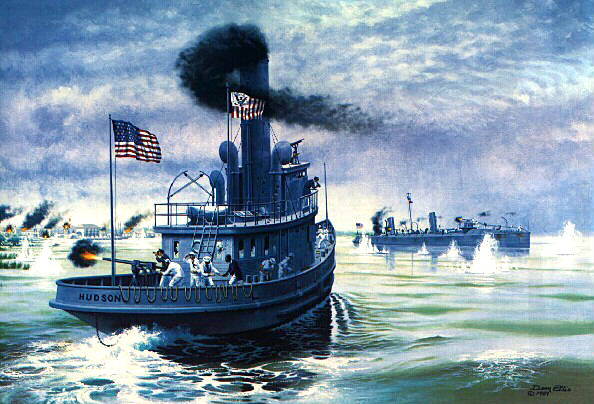
United States Coast Guard - 200th Anniversary
In 1898, when America declared war on Spain, the Revenue Cutter Service was once again placed under the Navy Department. Eight revenue cutters, carrying forty-three guns, served in Admiral William T. Sampson's fleet and helped blockade Cuban harbors. Hudson, one of the vessels transferred, was a harbor tug stationed in New York Harbor that had worked principally with the Customs Service. On May 31, Hudson, along with the navy gunboat Wilatingron and torpedo boat Winslow, were sent on a reconnaissance mission near Cardenas, Cuba. Winslow, far inshore of the other two warships, came under heavy fire. Wilutington and Hudson arrived shortly thereafter.
Five minutes after the firing of the first shots, the cutter Hudson steamed into action firing on the enemy's battery with its two 6-pounder Driggs-Schroeder guns. The enemy guns concentrated their fire on Winslow and thirty minutes after engaging the enemy, Winslow was observed moving in an erratic manner and nearly collided with Hudson. The fire of the enemy battery continued to be directed on the torpedo boat and many shells fell around Hudson. Hudson offered assistance to the apparently disabled Winslow, but the Navy vessel declined the offer. Fifteen minutes later, Winslow's officers, realizing that their ship could not be controlled, requested help from Hudson.
Getting a towline to Winslow proved to be a difficult task because the wind was blowing in the direction of the enemy and the water was extreme]y shallow. First Lieutenant Frank H. Newcomb maneuvered the ship through unknown waters while Hudson's propellor stirred the bottom. During this time, Hudson's crew kept up an intense and effective fire on the shore battery. Moses Jones, the black steward, was specifically mentioned in the captain's report for his gallant service at the after gun. Thirty minutes elapsed before the cutter successfully passed a line between the two vessels. Meanwhile, shells continued to strike the torpedo boat and passed overhead and near Hudson. Just before the towline was secured and the Winslow was pulled to safety, a bursting shell killed an officer and three men on board the Navy warship.
For their distinguished service, all of Hudson '5 officers and crew received medals from Congress. Other revenue cutters serving with the Navy also performed important duties during the war and were commended for their valuable service by the Secretary of the Navy and the President of the United States.
Artist: Dean Ellis
